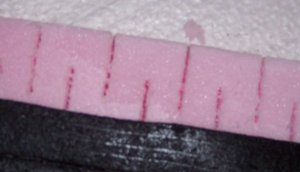Inclines would be difficult to cut with the handtools (or hand-held tools) you have. However, you can make a hotwire cutter for about $5 or so... The key is the "nichrome" wire. You can get this as a replacement part from WoodlandScenics without buying their hot wire cutter.
The key to getting a straight edge is to clamp the foam between two straight edges, like some 1x2 or 1x3 pine. Clamp it on both sides of the foam by putting a screw (or three or four) right through the foam from one side to the other. Make sure they match!
The hot wire cutter is made from the nichrome wire, some bell/telephone/lamp wire and a standard powerpack. Make some sort of U-shaped handle, and stretch the nichrome across the end. Hook it up to the variable output on the powerpack using the bell wire. The "faster" you go with the control - the hotter the wire gets.
The wire should be hot to cut, and it should not take any effort to move it through the foam. If you have to push/pull it, you are going too fast, or the wire is too cold. Run the hot wire along the 1x3 guides you screwed to the foam.
To make the curves, turn the riser on its side, and cut very thin wedges out of the side. They should go about 2/3 of the way through. With wedges cut only from one side, it will only bend one way, so turn it over if your curve goes the other way...

You will end up with something that looks like the WS risers, but at a much lower cost.
Good luck!
Andrew


